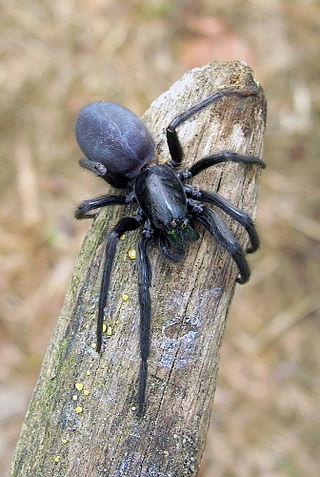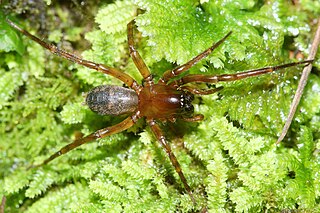
Tube-dwelling spiders (Segestriidae) are a family of araneomorph spiders first described by Eugène Simon in 1893. It consists of five genera, two large and widespread, Segestria and Ariadna, and three smaller genera, Citharoceps, Gippsicola and Indoseges. They are haplogyne spiders, related to the Dysderidae and placed in clade or superfamily Dysderoidea.

Liocranidae is a family of araneomorph spiders first described by Eugène Simon in 1897. They are one of several groups called "sac spiders". The holarctic genus Agroeca is the best-known, but it also includes various genera of more obscure spiders that still lack a diagnosis. Two species in the North American genus Neoanagraphis are found in the extremely dry conditions in the Mojave, Sonoran and Chihuahuan deserts. Females live in animal burrows while males wander and are the ones most often caught in pitfall traps.

Cyatholipidae is a family of spiders first described by Eugène Simon in 1894. Most live in moist montane forest, though several species, including Scharffia rossi, live in dry savannah regions. They occur in Africa, including Madagascar, New Zealand and Australia, and one species in Jamaica. Most members of this family hang beneath sheet webs. Fossil species occur in the Eocene aged Bitterfield and Baltic Ambers, suggesting a wider geographic distribution in the past.

Mecysmaucheniidae is a family of araneomorph spiders first described by Eugène Simon in 1895. Most genera occur in South America, with two genera endemic to New Zealand.

Porrhothele is a genus of mygalomorph spiders endemic to New Zealand. They are the only members of the family Porrhothelidae. They were first described by Eugène Louis Simon in 1892. Originally placed with the curtain web spiders, it was moved to the Hexathelidae in 1980, they were placed in their own family in 2018.
Rhondes is a genus of New Caledonian jumping spiders that was first described by Eugène Louis Simon in 1901. It was briefly considered a synonym of Hasarius, but was revalidated after the results of a 2008 molecular study. It is now grouped with several other Australasian genera in the unranked clade Astioida.
Loxoptygus is a genus of African tarantulas that was first described by Eugène Louis Simon in 1903. As of March 2020 it contains two species, found in Ethiopia: L. coturnatus and L. ectypus. It was removed from the synonymy of Phoneyusa, and is considered a senior synonym of Loxoptygella.

Hexathele is a genus of tunnelweb spiders endemic to New Zealand that was first described by Anton Ausserer in 1871, though most others have been described by Raymond Robert Forster. Originally placed with the curtain web spiders, it was moved to the Hexathelidae in 1980.

Amphinecta is a genus of South Pacific intertidal spiders first described by Eugène Simon in 1898.
Anapis is a genus of araneomorph spiders in the family Anapidae, which consists of small orb weaving spiders all from the Neotropical realm. The genus includes close to thirty species and was first described by Eugène Simon in 1895.
Cepheia is a monotypic genus of European araneomorph spiders in the family Synaphridae containing the single species, Cepheia longiseta. It was first described as Theonoe longiseta in 1881, and was moved to its own genus in 1894. Originally placed with the tangle-web spiders, it was moved several times before settling in the Synaphridae in 2003. Paolo Brignoli noted that it is an unidentifiable theridiid.

Cladomelea is a genus of African orb-weaver spiders first described by Eugène Simon in 1895. Adult females of the genus are bolas spiders, capturing their prey with one or more sticky drops at the end of a single line of silk rather than in a web. Males and juvenile females capture their prey directly with their legs.
Orsolobus is a genus of South American araneomorph spiders in the family Orsolobidae, and was first described by Eugène Louis Simon in 1893.

Haplinis is a genus of South Pacific dwarf spiders that was first described by Eugène Louis Simon in 1894.

Pholcomma is a genus of comb-footed spiders that was first described by Tamerlan Thorell in 1869.
Chthonos is a genus of South American ray spiders that was created by Jonathan A. Coddington in 1986 because the previous name was preoccupied. Originally placed with the Orb-weaver_spiders under the name Tecmessa, it was transferred to the ray spiders in 1986.
Avelis is a monotypic genus of African crab spiders containing the single species, Avelis hystriculus. It was first described by Eugène Louis Simon in 1895, and all identified species were found in the Cape Province of South Africa.
Periegops suterii is a species of spider in the genus Periegops that is endemic to the South Island of New Zealand.
Periegops keani is a species of spider in the genus Periegops that is endemic to the North Island of New Zealand.
Periegops australia is a species of spider in the genus Periegops that is endemic to South East Queensland in Australia.










